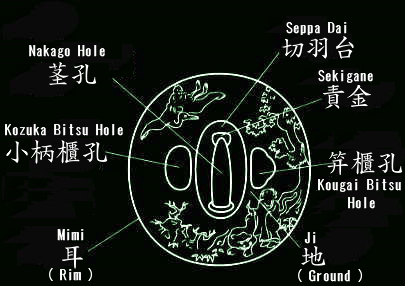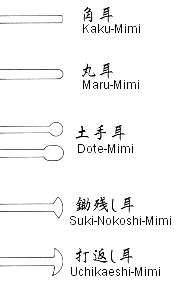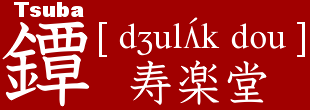Japanese Sword Glossary
| A | B | C | D | E | F | G | H | I |
| J | K | L | M | N | O | P | Q | R |
| S | T | U | V | W | X | Y | Z |

| A | Aikuchi | Short sword without sword guard. |
| Amida-Yasuri | A kind of pattern carved on sword guard. Amida means Buddha. So, Amida-Yasuri is a pattern like Halo. |
|
| B | Bashin | Originally, bashin were used for exsanguinating blood of congested horses. Though, Samurai used bashin instead of Kozuka or Shuriken (throwing star). Kozuka consists of blade and handle. Bashin consists of only one part. |
| D | Dai-Sho | A standard pair of swords, one long and one short, worn by warriors during the New Sword (Shin-to) period. |
| Dotemimi | One of the shapes of rim parts of sword guards. Rim part is banked. |
|
| F | Fuchi | Collar on hilt. Fuchi and Kashira were usually made in pairs. |
| H | Habaki | Collar around the blade just below the guard, for the purpose of assuring a tight fit between the scabbard and the blade. |
| I | Iroe | A type of inlay. Braze thin golden or silver sheet on a ground metal. |
| K | Kanteisho | Expert evidence. Certificate. |
| Kao | An artist's monogram. In the form of a stylized kanji. | |
| Kashira | Pommel at the base of the hilt. Usually paired with Fuchi. | |
| Katana | Japanese single-edged sword. | |
| Katchushi | Armor maker | |
| Kougai | Hair skewer usually inserted in a pocket on a scabbard. Use for combing tangles out of Samurai's hair. |
|
| Kozuka | Utility knife which is usually inserted in a pocket on the scabbard. Consists of a Hitsu (handle) and a Ho (blade). | |
| Kusarashi | Express patterns or motifs on iron sword guards by chemical reaction. It looks like very shallow carving. |
|
| M | Mei | Signature, inscription, touchmark. Usually inscribed on Seppa Dai of a tsuba. In case of sword, the Mei is inscribed on the tang of a blade. |
| Mekugi | A peg, generally made of bamboo, used to fasten the blade into the hilt. | |
| Mekugi-Ana | Peg hole (or holes) in the tang of a blade. | |
| Menuki | Hilt ornaments to cover the Mekugi-Ana. | |
| Migaki-Ji | Polished surface. Polish surface with grinding stone or charcoal. | |
| Mimi | Rim part of tsuba

|
|
| Motokoromono | A set of three Koshirae ornaments. They are Menuki, Kozuka and Kougai. | |
| Mokume-Hada | Burl grain. | |
| N | Nakago | The tang. The portion of the blade which is inserted in the handle. |
| Nanako-Ji | Processed surface like hard roe. uses Nanako chisel. | |
| Nara-Sansaku | Big three of the Nara school. Nara Toshinaga, Sugiura Joi and Tsuchiya Yasuchika. | |
| O | Oboro-Gin | Alloy of copper and silver. The same meaning as Shibuichi. |
| R | Ranma-Bori | Carving like transom window. |
| S | Samegawa | Skin of the giant ray. Used for binding hilts and decorating scabbards. |
| Samurai | Warrior or knight of the feudal era. | |
| Saya | scabbard. Sheath. | |
| Shakudo | red copper. alloy of copper and gold. | |
| Shibuichi | alloy of copper and silver. Usually Copper 4 to Silver 1. | |
| Sori | curvature of a sword blade | |
| Suaka | Smelted copper. | |
| Sukashi | Openwork | |
| Sukidashi-Bori | Relief carving. | |
| T | Tachi | Sword which is worn edge-down. Slung from a belt. |
| Takabori (Takanikubori) |
High relief carving | |
| Tsuba | A sword guard. | |
| Tsuchime-Ji | Surface in hammered finish. | |
| Tsuka | Hilt or handle. | |
| U | Uchigatana | Sword which is worn edge-up. This type of sword became popular after the Muromachi period. |
| W | Wakizashi | A medium-sized blade between 30 and 60 cm in length. A blade under 40 cm is called a Ko-Wakizashi. |
| Y | Yamagane | Coarse copper. |
| Yoroi | Samurai armor. | |
| Z | Zogan | Inlay. |
